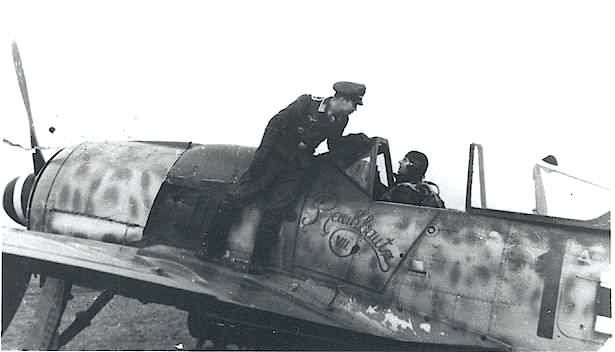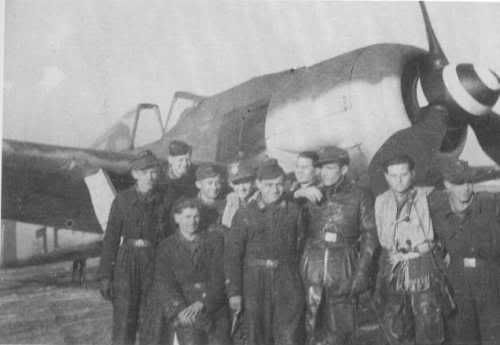It could also a straggling aircraft wich was damadeg earlier.
The Fw-190s over the invation Front, June 1944.
[SIZE=2][/SIZE]
[SIZE=2]by Don Caldwell[/SIZE]
[SIZE=2]
[/SIZE]…By the spring of 1944 every member of the JG 26 Geschwader knew that an Allied invasion was imminent. The Allies were expected to come ashore somewhere on the coast of the Pas de Calais, which put JG 26 right on the firing line. The OKL had a long-standing plan to reinforce Luftflotte 3 with fighter units from Germany once the enemy landings began. JG 2 and JG 26 would provide the experienced nucleus for the 5th Jagddivision, which would command the “pure” fighter units under Genmaj. Werner Junck’s Jagdkorps II. About half of the new Jagdgruppen would join Genlt. Alfred Buelowius’s Fliegerkorps II, a ground attack command that had established a fully-staffed headquarters in France in advance of the invasion.
Priller

…The Geschwader was far below its authorized strength in aircraft and pilots, but was in its best shape in months. Obstlt. Priller’s Geschwaderstab and the First and Second Gruppen were equipped almost entirely with the Fw 190A-8. An improved Fw 190A-7, it would become the Fw 190 model built in the greatest numbers, 1334 eventually rolling off the production lines. The Fw 190A-8 retained the A-7’s powerful armament of four wing-mounted MG 151s and two cowling-mounted MG 131s, although some examples had the outer wing cannon removed to save weight. It had a new radio with homing capabilities and a new 25 gallon fuel tank behind the cockpit. In the R4 variant this fuel tank was replaced by a nitrous oxide tank in a system called GM-1 boost, which increased top speed by as much as 36 mph at altitudes above 8000 meters (26,000 feet). The Fw 190A-8 had the same 1700 HP BMW 801D-2 engine that had powered the Fw 190A-3 in 1942, so the boost was necessary to remain competitive with improved Allied fighters. GM-1 raised the fighter’s critical altitude from 5500 to 6300 meters (18,000 to 20,700 feet) at which height its maximum speed was 656 km/h (408 mph).

At low or medium altitudes the performance of this fighter was comparable to that of the four principal Allied types, and its pilots, even the new ones, had a great deal of confidence in their mount.
…The Third Gruppe was still flying its old Bf 109G-6 Beulen (boils), so named from the bulbous fairings covering the breeches of their cowling-mounted MG 131 machine guns. While still an effective dogfighter, the Bf 109 was showing its age, and lacked the speed necessary to initiate combat or escape from Allied fighters. An experienced pilot could use its ability to climb and turn to regain the advantage if caught by surprise; inexperienced pilots, who were the great majority, were easy targets.
…As the Allies completed their preparations for the invasion, the Germans still had no clue as to its date or location. Rain and mists covering France in early June led to a reduction in the Wehrmacht state of readiness. The First Gruppe kept up its routine of flying from its northern bases to Trier or Metz in the morning, and returning in the evening. The Second Gruppe continued training at Mont de Marsan. The Third Gruppe remained on Nancy-Essey, and was scrambled a few times. Contact was not sought with the enemy.
…On 4 June the Allied air forces kept up a blizzard of attacks on tactical objectives in France. In England, the assault craft had been loaded and were on their way to the Normandy beaches when an urgent message from SHAEF was received postponing the D-Day landings one day, from 5 June to 6 June, to take advantage of a predicted improvement in the weather. The convoys put back into port, still unobserved by the Luftwaffe.
…Jagdgeschwader 26 got word of the Normandy invasion via a telephone call to Obstlt. Priller at his Lille-Nord command post. Priller was told that JG 26 had been put under the command of the 5th Jagddivision, and that he should begin transferring his Gruppen to bases nearer to the beachhead area. Orders were quickly passed to the nearby First Gruppe and to the Third Gruppe at Nancy-Essey to get their operational fighters airborne and en route to the JG 2 airfields at Creil and Cormeilles. His staff was told to load their trucks and head south toward Poix. The First and Third Gruppe truck convoys were already on the road with those units’ ground staffs, but were unfortunately headed in the wrong direction. The First was going to Reims in anticipation of a permanent base move; the Third was moving southeast to join its flying units at Nancy. Priller had fought the orders for these transfers into the French interior, but had lost. The convoys were located by radio and told to stop. Hptm. Naumann’s Second Gruppe pilots had already taken off from Mont de Marsan and Biarritz at 0700 and had reached Vrox, where they awaited further orders. Beyond telling the Second Gruppe ground staff to pack up, Priller had no orders at the moment; the unexpected Allied landing site had upset all the Luftwaffe plans. Having done all he could, Priller and his wingman, Uffz. Heinz Wodarczyk, headed for their Focke-Wulfs, which as usual were parked just outside the command post. The first Luftwaffe response to the invasion was underway.

to be continued…


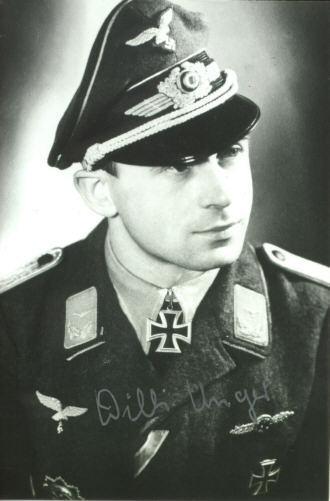

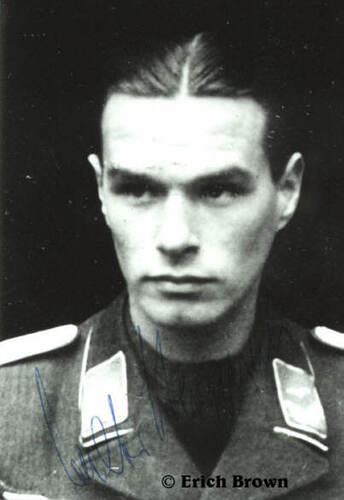
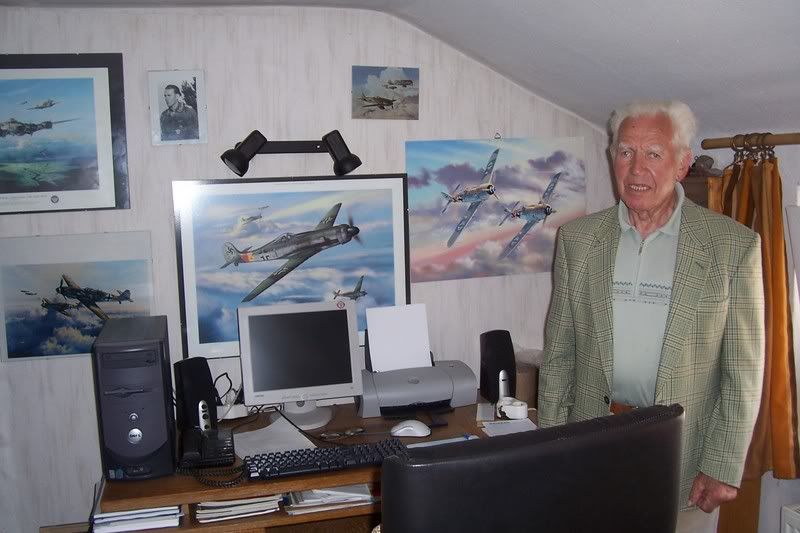
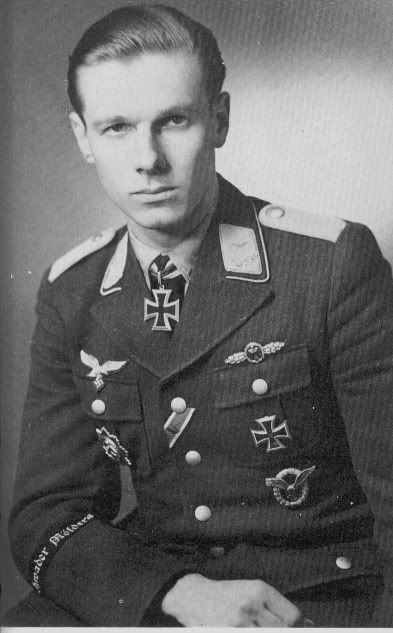


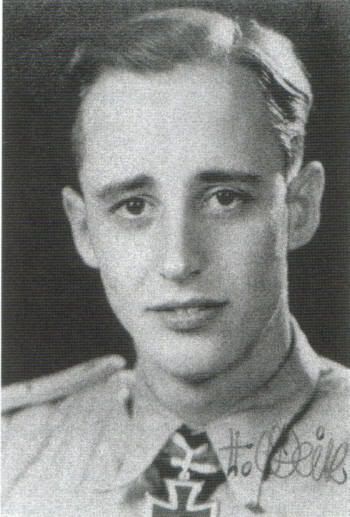


 Danke, I saw this aircraft captioned as the Hans Phillip FW.
Danke, I saw this aircraft captioned as the Hans Phillip FW.